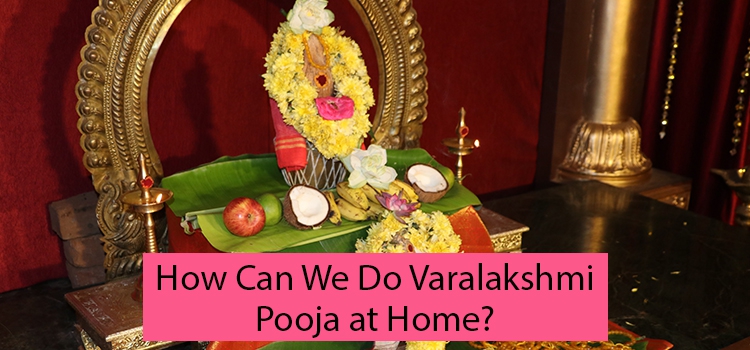How can We Do Varalakshmi Pooja at Home?
Varalakshmi Vratham
Varalakshmi Vratham is a widely celebrated festival dedicated to Vara Lakshmi, the boon-bestowing aspect of Lakshmi, the supreme Goddess of wealth, fortune, and auspiciousness. This is a ceremonious worship done mainly by married women and is quite prevalent in the Southern states like Andhra Pradesh, Telangana, Karnataka, Kerala, and Tamil Nadu.
This is observed in the month of Shravana (July-August) on the second Friday of Shukla Paksha, the Moon’s waxing phase, or on the Friday before Purnima, the Full Moon. In the current year, Varalakshmi Vratham 2021 falls on 20th August.
It is believed that this worship on the auspicious occasion can please Ashtalakshmi, all the 8 powerful forms of the Mother Goddess, and earn their beneficial blessings for the devotees.

Join In Our 4-Priest Vasudha Mahalakshmi Homam
Pooja Preparations
Varalakshmi Vratham is an ancient festival, observed following well-established procedures. However, some of its practices vary at least slightly, from region to region, while family traditions also contribute to differences in the way it is observed.
Broadly, Varalakshmi Vratham Pooja involves the worshipping of a sacred pot, known as Kalasa or Kalasam, and the image of the Goddess placed on it. The Kalasam is generally of silver or bronze. Some fill it with water and add spices like cardamom, edible camphor, nutmeg, etc., to it for fragrance. There are also families who fill this Kalasam with rice grains, lemon, betel leaves, nuts, turmeric sticks, molded jaggery, dry fruits, a rosary made of black beads, etc.
People cover the mouth of the Kalasam with green mango leaves in odd numbers and place a turmeric-smeared coconut on it, with its tail portion pointing upwards. Then, a silver image of Goddess Varalakshmi or her face is installed on top of the Kalasam, covering the front portion of the coconut. This Varalakshmi image or face remains the deity of worship in the Varalakshmi Vratham Pooja.
People apply saffron and sandal paste on the deity’s forehead and also on the sacred pot. They also decorate the image and Kalasam with colorful silk dresses and clothes, gold ornaments, and flower garlands.
Sacred threads called variously as Saradu or Pongu Nool also remain part of this worship. Soaked in turmeric paste, these yellow threads each carry 9 knots, tied at equal intervals. These are also worshiped along with the deity in the Pooja. Believed to carry the protective blessings of the Goddess, these are worn by the women subsequently for their protection and welfare.
As part of the preparatory activities, the women sweep the house and floors, clean the traditional lamps and other materials for the Pooja, draw Rangolis at the entrance and other places, and decorate the house with festoons made of green mango leaves, on the previous day itself. They also prepare special items and food offerings for the Pooja or keep the ingredients ready.
Varalakshmi Vratham Pooja
Broadly, this Pooja can be said to consist of Ganapathi Pooja, Varalakshmi Avahan, Anga Pooja, Saradu Pooja, Neivedhyam offerings, and Aarti. Also, Vratham generally denotes the austerity of fasting, and so, women take food on the day only after performing the Pooja.
On the morning of Varalakshmi Vratham Friday, women get up early, bathe, and dress themselves up in their finery and flowers. They then draw Kolam or Rangoli with rice flour at the place earmarked for the Pooja, put a wooden plank on it, spread a banana leaf on it, and keep raw rice spread over it. At the auspicious time of the day, the Kalasam with the deity will be installed on it, facing the East. Traditional oil lamps are lit in front, joss sticks are lighted, and food and fruit offerings are placed before the altar.
Lord Ganesha is the obstacle-remover and success-provider, and so all auspicious events begin with his worship. Here, a cone made of turmeric paste is worshiped as Ganesha, hymns dedicated to him are chanted, and flowers are offered to him.
Then Varalashmi is invited to the house with love and devotion by performing the Avahan Pooja. Here, she is welcomed with the chanting of Avahan Sloka and offering of flowers and Akshatha, the turmeric mixed rice.
Then Anga Pooja Sthothra is recited, flowers are offered, and Anga Pooja is performed to the deity by worshiping her from head to foot, part by part. People then pray to the Goddess by taking her 108 sacred names and chanting Lakshmi Ashtothram and offering flowers simultaneously. Saradu, the sacred threads are also worshiped then.
The special preparations for the day, like the sweets and other food items, are then offered as Neivedhya to the Goddess. Then, Mangal Arti is performed as the concluding worship by offering turmeric and saffron mixed water and waving the lighted camphor before the altar. The ladies sing Arti songs to mark the successful completion of the Pooja.
Devotees thank the Goddess for visiting their houses on the auspicious day and seek her blessings for their wealth, good health, prosperity, progress, all-round welfare, and joy. While the sacred threads sanctified in the Pooja are worn by the women in their right wrists, Thamboolam, the items denoting auspiciousness are distributed to the women along with the food offerings.



















